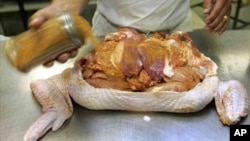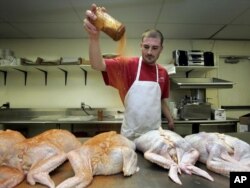In most of the United States, November and December are prime time for turkey lovers. The U.S. Poultry and Egg Association says 46 million turkeys are eaten on Thanksgiving, with another 22 million consumed on Christmas.
But in the Southern state of Louisiana, known for its decadence and creative cuisine, turkey has a competitor. For people in and around cities including New Orleans, Baton Rouge and Lafayette, it’s turducken that is the talk of the town.
“Turducken is a chicken stuffed inside a duck stuffed inside a turkey,” said Ellis Lanaux, chief executive officer of Langenstein’s, the oldest full-service grocery store in New Orleans, open since 1922.
“It’s part of this unique culinary culture we have down here,” Lanaux told VOA. “There’s nothing like our food elsewhere in America, and you see that uniqueness on our Thanksgiving table. In addition to mainstream staples like mashed potatoes and green beans, you also find Cajun dishes like chargrilled oysters, oyster dressing, cornbread and crawfish stuffing, mirliton casserole, and — if you’re lucky — a turducken.”
In addition to the trio of birds, dressing (a term in some parts of the U.S. often used interchangeably with stuffing) is added between each layer. Some turducken creators ask shoppers to choose a single dressing, with oyster dressing and cornbread and crawfish dressing among the most popular.
Others, including Hebert's Specialty Meats, allow as many as three dressings, with alligator, boudin sausage, shrimp etouffee and rice, crawfish jalapeno cornbread, jambalaya, and wild rice and pecan among the many possibilities between layers of poultry.
When sliced, the creation presents almost like a layered French terrine.
“Eating turducken isn’t for the faint of heart, and neither is preparing one,” laughed restaurateur Brenda Prudhomme. “It takes forever. You have to prepare your dressing, you have to get your birds, you have to debone each of them, you have to stuff them and layer the dressings, you have to season them, and then you basically have to become a seamstress and sew them in together. It isn’t easy, but it brings a lot of people joy so we do it!”
Part of a long tradition
Hebert’s Specialty Meats sells thousands of turduckens each year, with spikes at both Thanksgiving and Christmas. At Chris’s Specialty Foods, the Turducken Roll Package is advertised as “enough turducken for a small banquet,” while its Holiday Turducken Feast serves even more.
The words “banquet” and “feast” aren’t accidental: Turducken is part of a larger, and older, tradition known as engastration, a cooking technique in which the remains of one animal are stuffed into another.
“It’s a tradition that reaches back to the Middle Ages, and even has roots in ancient Rome,” said Liz Williams, founder of the Southern Food and Beverage Museum in New Orleans. “It’s a culinary practice that would show up at feasts for royalty and enjoyed by the wealthy. Compared to what they were stuffing back then, filling a turkey with a duck and a chicken, quite frankly, is chump change.”
The famed Trojan Boar from the Roman Empire, for example, was a 1,000-pound hog stuffed with game birds and other small animals.
The Roti Sans Pareil, or the Roast Without Equal, was a 19th-century dish created by French gastronomist Alexandre Balthazar Laurent Grimod de la Reyniere. The creation included an extraordinary 17 stuffed birds: bustard, chicken, duck, garden warbler, goose, guinea fowl, lapwing, lark, ortolan bunting, partridge, pheasant, plover, quail, teal, thrush, turkey and woodcock.
And, still today, the Inuits of Greenland are known to enjoy kiviak, a traditional winter community dish of seal stuffed with as many as 500 birds.
While turducken is far more modest, Lenore Newman, author of Lost Feast: Culinary Extinction and the Future of Food, said this Louisiana Thanksgiving feast food likely comes from a similar tradition.
“It’s a dish intended to impress,” she told VOA. “That’s a commonality among dishes using engastration: They are meant to wow.”
Debated origin
Turducken most definitely wows - so much so that there are competing claims to its origin.
Many say it was Paul Prudhomme, who popularized Cajun cuisine on a national stage with his catalog of successful cookbooks and his public television show, "Chef Paul Prudhomme's Always Cooking!" Prudhomme copyrighted the name in 1986, but others believe it was Hebert’s that created the dish a year earlier.
“A farmer walked into our store carrying a turkey, a duck and a chicken, and they asked our owners to stuff them into each other,” said Scott Catlett, the owner of several Hebert’s locations. “We thought it was a little weird, but we’re always willing to try anything once and thankfully we did!”
Some even credit turducken’s invention to New Orleans surgeon Gerald R. LaNasa. As early as the 1960s, he was locally known to use his scalpel while deboning the three birds before stuffing them — sometimes adding pork or veal roasts, andouille sausage or foie gras into the final hen’s cavity.
“I think it’s usually impossible to pin food down to one inventor because cuisine evolves and people build off of each other’s ideas,” said Williams from the Southern Food and Beverage Museum. “But the fact that there are so many competing popular stories shows just how beloved turducken has become.”
Though the debate over who created the trilogy of birds continues, there is no dispute about when the dish rose to national prominence.
That was in 1997 when American football television announcer John Madden carved into a turducken during a Thanksgiving game hosted by the New Orleans Saints. Turducken became a regular part of his Thanksgiving broadcasts, with Madden handing out turkey legs to that game’s best players.
Despite its popularity, with thousands now shipped annually from Louisiana, not everyone is impressed.
“I call it a medieval pile of poo!” laughed Poppy Tooker, host of a weekly radio show, "Louisiana Eats!" “If you’re hoping for the familiar flavor of a turkey breast, or a rich duck, or a delicious chicken, I’m afraid you’re not going to get any of that because it all gets jumbled together into a mess.”
Still, Tooker acknowledged there is something about turducken that captures the spirit of the region from which it came.
“Louisianians — men and women — aren’t afraid to roll their sleeves up in the kitchen and take on a complicated dish,” she said. “This is definitely one of them. It might not be a recipe that came from your grandmother, but it’s a newer tradition that says something about our culture, for sure. People are wild about it here.”
To find out what side of the turducken debate you fall on — delicious or not — Prudhomme advised in his 1987 “The Prudhomme Family Cookbook” to try making one yourself.
"Each time you do a turducken, it will become easier,” he wrote. “It doesn't take magical cooking ability; it just takes care. What is magical is the way people who eat it will feel about your cooking."










